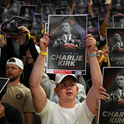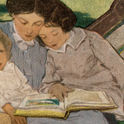In the summer of 1938 the French surrealist writer André Breton visited Mexico City. During his visit he spent much time with Leon Trotsky, then living in exile and in constant fear of assassination by Stalinists. On his return to Paris, Breton gave a glowing description of Trotsky and his small circle of followers, assistants and protectors, singling out for particular praise a man he called “Comrade Van,” who worked as both Trotsky’s secretary and his bodyguard. “Anyone who has anything to do with him,” Breton said, “is aware of his extraordinary intelligence and sensitivity and the quickness and clarity of his judgment… I hope he will pardon me for speaking about how moving his life is.” He went on to give a brief account of Comrade Van’s life, emphasising the moment when, at the age of 18, though he had been admitted to the École normale supérieure, he gave up everything and “spontaneously offered his services to Trotsky.” “At present, he is very poor,” Breton told his listeners, “because Trotsky does not have the means to give anything to his secretaries except room and board. He continues to live without having the least little thing in the way of personal possessions.” He ended by describing Comrade Van as “everything Trotsky could want in a man… here is a real man, a friend in every sense of the word.”
You might have expected the object of this panegyric to be flattered, but Comrade Van was anything but. Instead, he wrote to Breton to correct some of the inaccuracies in his speech. He was 20, not 18, when he went to work for Trotsky, he told him. And he did not “spontaneously offer his service,” he had been asked. As for being “very poor,” that was not how he saw it. He was serving a cause, and money had nothing to do it with it. After all, did the disciples expect payment from Jesus?
Comrade Van evidently was a man for whom precision and accuracy were important, a trait that served him well in later life when he switched from political activism to academia. To philosophers, logicians and mathematicians he is known by the name given to him at birth: Jean van Heijenoort, the editor of From Frege to Gödel: A Source Book in Mathematical Logic, 1879-1931, a book that has been regarded as essential by serious Anglophone students of logic since its appearance in 1967. It contains English versions of the most important contributions to the subject during a crucial period in its development. The papers, many of which had previously been available only in foreign languages or obscure journals, include indispensable writings by some of the most formidable minds of the late 19th and early 20th centuries: Russell (who is here with “Mathematical logic as based on the theory of types”), the Italian Peano (“The principles of arithmetic, presented by a new method”) and the Dutch Brouwer (“On the significance of the principle of excluded middle in mathematics, especially in function theory”), as well as the two geniuses who made the book’s title. Most readers of the book, I imagine, have no knowledge of van Heijenoort’s Trotskyist past, nor, indeed, unless they have read Anita Feferman’s excellent biography, From Trotsky to Gödel: The Life of Jean van Heijenoort, are they likely to know much about the life of this extraordinary man.
The story begins in 1912, when Jean van Heijenoort was born in Creil, France. His mother, Charlotte Hélène Baligny, who came from, as he put it, “peasant stock,” was a remarkably intelligent and resourceful woman who would remain throughout his life the person whom he loved and respected most. His father, Jean Théodore van Heijenoort, was a Dutchman who had come to France looking for work. Jean never truly knew his father because he died in September 1914, when Jean was still just two.
In the community in which he grew up, it was not expected that children would pursue an education beyond primary school, but Jean was so outstandingly brilliant that he was sent to the district secondary school, Clermont-de-l’Oise. There, to his mother’s great pride, he was top of almost every class he attended and won almost every prize on offer. From there he progressed to the prestigious Lycée Saint-Louis in Paris, where he was a member of a group of advanced mathematics students preparing for the École normale supérieure, but the rounded preparatory education he received was so excellent that by 1932, even without actually taking up his place at the elite institution, he had advanced knowledge of mathematics, philosophy, physics, chemistry and French literature and could read Latin, Greek and German. He also taught himself Russian. At this point, primarily because of his fluency in languages, he was hired to be Trotsky’s secretary.
He had been drawn to communism while still a schoolboy. At Clermont he joined a communist youth group; while in Paris he joined the Ligue Communiste, the French affiliate of Trotsky’s International Left Opposition. He was by this time so committed to the cause that when he was asked by the leader of the movement in France, Raymond Molinier, if he would consider working as Trotsky’s secretary, he had no hesitation in abandoning his plans of further study and travelling to Prinkipo Island in Turkey, where Trotsky and his partner Natalia had been living in exile since 1929.
For the next seven years, van Heijenoort was Trotsky’s right-hand man, making arrangements on his behalf and transcribing and translating his writings, which in these years covered the deteriorating situation in Europe and the nature of the Nazi threat as well as developments in the Soviet Union. Van Heijenoort also acted as Trotsky’s bodyguard, carrying a gun at all times. Trotsky was forced to keep on the move during those years, and van Heijenoort accompanied him to Denmark, France, Norway and, finally, Mexico City. During that time, he got to know Trotsky extremely well, as he describes in With Trotsky in Exile: From Prinkipo to Coyoacán, published in 1978.
Despite the constant anxiety that Trotsky would be targeted by Stalinist assassins, life in Mexico City, for a short time at least, was fairly pleasant for their small entourage. They mixed with intellectuals, political activists and artists, including Diego Rivera, thanks to whom they had a very nice house in which to live. It is now famous as Frida Kahlo’s “blue house,” the home of the museum dedicated to her life and painting. Like many men before and after him, van Heijenoort became bewitched by Kahlo’s charm, outspokenness and beauty. He had an affair with her that, though brief and discreet, was something that he cherished for the rest of his life. “Ah, Frida,” he once said. “She was one of the great women of my life. Deeply sensual, extremely intelligent, strikingly beautiful, she was like no other woman I have ever known.”
In Mexico, van Heijenoort played a large role in putting together Trotsky’s defence against the accusations made about him during the show trials held in Moscow in 1936 and 1937. At Trotsky’s request, an international commission of inquiry was set up, with the eminent philosopher John Dewey as its chairman, to investigate the charges made by Stalin. The task of preparing for the inquiry was huge, and much of it fell to van Heijenoort. He was in charge of searching the massive pile of relevant documents that Trotsky had collected, of issuing the daily press releases and, as ever, of security. The hearings took place in April 1937, and were extensively covered by the world’s media. Almost every photograph of Trotsky at the hearings has van Heijenoort sitting to his right. Dewey described working on the commission as “the most interesting single intellectual experience of my life.” The verdict reached was that Trotsky was “not guilty” of Stalin’s charges.
Before moving to Mexico, during Trotsky’s exile in France, van Heijenoort had married Gaby Brausch, a fellow communist he had met while a student in Paris. Three months later, Gaby gave birth to their son, Jean, who would be known throughout his life as Jeannot. When the time came for Trotsky to leave France, Jeannot was still just a few months old, but van Heijenoort had no qualms about leaving him and Gaby to accompany Trotsky wherever he went. In November 1937, Gaby and Jeannot rejoined van Heijenoort in Mexico. However, Gaby and Natalia—no strangers to conflict—had an argument so intense that Gaby felt she had to leave. “This time,” van Heijenoort said later, “we both knew that it was really the end.” Their marriage was over.
In the summer of 1939, van Heijenoort married again, this time to a young American called Bunny Guyer, who had come to Mexico to meet Trotsky. A few months later, van Heijenoort decided that he had to leave Mexico. “I had lived for so many years in the shadow of Trotsky,” he later explained, “that I needed to be by myself for myself.” They settled in New York, so that van Heijenoort could investigate the American Trotskyist movement at Trotsky’s behest. It was assumed that he would return to Mexico again before too long. In fact, he never saw Trotsky again.
In New York, while Bunny acted as the breadwinner, van Heijenoort had meetings with the American Trotskyists, wrote articles for their journal, the Fourth International, and spent as much time as he could in the New York City Public Library on 42nd Street, voraciously reading works of history, politics, literature, philosophy and mathematics. The van Heijenoorts moved frequently between New York, Philadelphia and Baltimore. They were in Baltimore when, on 21st August 1940, news came that Trotsky had been assassinated. Van Heijenoort, inevitably, blamed himself. If he had been there, he insisted, he would have recognised immediately that the assassin, the Spaniard Ramón Mercader, was not, as he claimed to be, a Belgian. “I would never have let Mercader into the house to talk to Trotsky alone.”
The last sentence of van Heijenoort’s book, With Trotsky in Exile is: “Darkness set in,” and one has a sense that, after Trotsky’s death, van Heijenoort’s world was a gloomier, colder place than it had been when he was still alive. For the following few years he kept up his association with the American Trotskyists and continued to write for them but, bit by bit, he moved away from political activism and towards academia. In the summer of 1945, he enrolled as a graduate student in mathematics at New York University and, from then on, academic study occupied him more than Trotskyism. The final break came in 1948 when he published an article called “A Century’s Balance Sheet,” in which he repudiated all forms of Marxism. “Bolshevik ideology,” he later said, “was, for me, in ruins. I had to build another life.”
[su_pullquote]“On 21st August 1940, news came that Trotsky had been assassinated. Van Heijenoort, inevitably, blamed himself”[/su_pullquote]
And so, “Comrade Van” became a US citizen and started calling himself “John van Heijenoort.” In the second half of his life, the obsessive precision he had previously brought to bear in his work for Trotsky and his political thinking and political writing would be redirected. He now began to publish brilliantly-written articles on logic, mostly of a historical or expository nature and, for seven years, devoted himself to compiling his source book on mathematical logic. He also helped to edit the papers of Kurt Gödel, known for his famous (and famously difficult) Incompleteness Theorems, which establish that there can be no consistent axiomatic theory of logic from which the whole of mathematics can be derived, a man who has been called the most important logician since Aristotle.
Van Heijenoort’s connection with Trotsky was not altogether forgotten, however. He was heavily involved in the acquisition by Harvard of Trotsky’s papers and in 1958, he returned to Mexico to negotiate with Natalia the addition of her papers to that archive. But Trotsky’s grandson, Sieva, noted sadly that the previously charming, active, dynamic and sympathetic Van had become a different person: “silent, sad, distant.”
By this time, not only had van Heijenoort’s second marriage fallen apart but, within a few years, he had married and divorced a third wife. In Mexico City he married his fourth wife, Anne-Marie, the daughter of Natalia’s lawyer. This was to be the most tempestuous marriage of them all. They divorced in 1981 and then remarried three years later. As Anne-Marie’s mental state deteriorated, so did their relationship. They kept breaking up, only to get back together again. When van Heijenoort tried to make a final break, Anne-Marie threatened to kill herself. “Of course, she wants to kill me too,” van Heijenoort told a friend. In March 1986, he headed from Stanford back once more to Mexico City, to try to reason with her. Two days after he arrived, Anne-Marie’s maid found his dead body in bed. Three shots had been fired into his head. After killing him, Anne-Marie had put the gun into her own mouth and fired once more.
Few people know of the turbulent life that van Heijenoort led, but From Frege to Gödel: A Source Book in Mathematical Logic, 1879-1931 remains an essential purchase for all serious students of logic.












